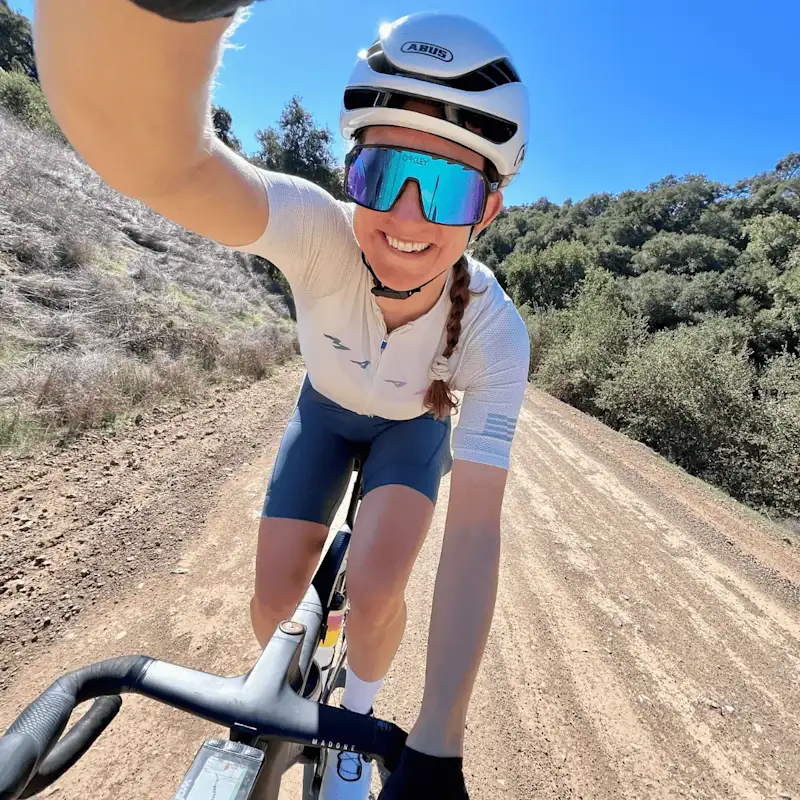
Paige Onweller
Unbound Gravel 200
Paige's headline numbers
Paige's strategy
Fueling
Carbohydrate is the main fuel you burn when racing. Failing to fuel properly is a leading cause of underperformance in longer races.
Paige came into Unbound with a meticulous fuel plan that began with a two-day carb load of close to ~580g (9g/kg) of carbohydrate on Thursday and ~720g (11g/kg) on Friday. After another good breakfast to top up her fuel stores on race morning and a final PF 30 Caffeine Gel, she went in with optimal glycogen stores and elevated blood glucose.
With cooler, faster and more hectic conditions than anticipated, she hadn’t drunk as much as planned from the carb-rich litre bottles on her frame by the time she reached the first checkpoint. Originally aiming for 90-100g/h, she achieved ~77g/h up to checkpoint one. As temperatures rose around mile 90, Paige started to feel nauseous and struggled to eat, but continued to drink from her fresh PF Carb & Electrolyte Drink Mix and PF Carb Only Drink Mix bottles to maintain ~78g/h. After some cooling through water dousing and an ice bandana at checkpoint two, she went on to reach ~91g/h to help sustain her performance to the finish line. Paige felt she would have benefitted from fewer carb-rich bottles, instead using a more decoupled fuel and hydration strategy to continue to hit her carb target. In future, she may want to consider doing this by relying more on PF 300 Flow Gel for her carbs, whilst hydrating separately with PH 1000, which she found easier to drink in the heat.
Hydration
Taking on board an appropriate amount of fluid and sodium is essential to maintaining blood volume and supporting the cardiovascular effort needed to perform on race day.
Whilst the absolute amount of sodium and fluid consumed per hour is important, it’s critical to consider these in relation to each other. This is known as 'relative sodium concentration' and it’s expressed in milligrams per litre (mg/L). How much sodium you’re taking in per litre of fluid is more important than the absolute amount taken in per hour.
Sweat sodium concentration (mg/L) is largely genetically determined and remains relatively stable. Knowing how salty your sweat is enables you to replace a good proportion of your sweat losses, which can range from 200-2,000mg/L.
Whilst Paige’s losses are on the low side, getting her hydration strategy right is still crucial when it’s hot and/or humid as her higher sweat rate in these conditions can result in significant net losses over the duration of a race.
Learn moreA pre-race Sweat Test helped Paige tailor her sodium replacement, taking in a relative sodium concentration close to that of her losses through the use of PF Carb & Electrolyte Drink Mix and PH 1000 (Drink Mix). She made the smart call to carry more water in her pack pre-race, but limited access to her bottles meant she drank under 500ml/h over the first three-and-a-half hours. After this point, she was more proactive with her fluid intake, finishing most of her bottles and packs, as well as kindly gifting a few sips of her strong carb-mix to a competitor who had lost a bottle. Despite the mild conditions early on, this early deficit may have contributed to the nausea and overheating she experienced between miles 90-120; collecting more sweat rate data in similar conditions at race intensity will help fine-tune her fluid intake next time.
Caffeine
Beyond the Three Levers of Performance (carb, sodium and fluid), caffeine is one of only a few substances that is proven to improve performance for most endurance athletes as it can help stave off mental and physical fatigue.
Paige opted to skip one of her five planned PF 30 Caffeine Gels on race day to prioritise gut comfort. This was a sensible adjustment, as she still hit the overall recommended range to benefit from the stimulant’s ergogenic effects, and there’s some evidence to suggest large doses of caffeine can compromise thermoregulation in the heat. Once she felt better, she resumed with two more caffeine gels in the final few hours, helping to maintain focus and perceived energy through to the finish.
How Paige hit her numbers
Here's everything that Paige ate and drank on the day...
Paige's weapons of choice
Final thoughts
Paige's full stats
Data Confidence?
There is good confidence in the accuracy of the data reported. An athlete feels that the numbers closely reflect what they consumed despite a couple of estimations which may carry some degree of error. The majority of what was consumed is recorded to a high level of specificity (most volumes are known through the use of bottles brands quantities flavours). The numbers are very plausible and align with previous data recordings (if an athlete has collected data previously).